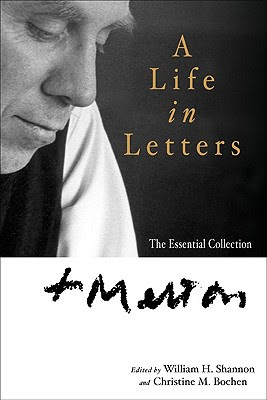 Thomas Merton: A Life in Letters: The Essential Collection
Thomas Merton: A Life in Letters: The Essential Collection
Edited by William H. Shannon and Christine M. Bochen
Notre Dame: Ave Maria Press, 2010
I came to “A Life in Letters” knowing relatively little about Thomas Merton. I had heard of him, knew he was a monk, and that he died in Asia in the 1960s. That was about the extent of it. I had never read a single word of his writings, although I had heard “Seven Storey Mountain” praised extensively on a number of occasions. For those, like me, who are approaching this book with relatively little background, the inclusion of a brief biography of the man behind the letters would have been appreciated.
My sense is, though, that most of the readers inclined to spend time with this book will already have been introduced to Merton and be familiar with his life and work. Within these pages, they will find a treasure.
Merton wrote over 10,000 letters in his life. Five volumes of his letters were previously published, each volume focusing on one area of Merton’s life and thought. “A Life in Letters” is an effort to present the highlights from that vast collection of letters. The editors, who no doubt had a daunting task, have succeeded well. From these letters come a portrait of a man who, though in craved solitude and lived as a hermit for several years, loved being a writer and enjoyed written discourse with people from all walks of life. He considered writing letters an extension of his vocation and was equally comfortable writing to well-known public figures of his day such as Pope John XXIII, the Kennedys, and Coretta Scott King as he was writing to a young student who was doing a school project on what life was like for a monk.
William H. Shannon and Christine M. Bochen have divided these excerpts from Merton’s letters into nine topical sections: A Life in Letters, Becoming and Being a Monk, Living the Writer’s Life, Speaking the Truth, Seeking God in the Ordinariness of Life, Reading the Signs of the Times, Networking for Peace, Keeping Faith in Times of Change, and Seeking Unity Beyond Difference. Each of these sections contain letters written over many years, allowing the reader to see both the consistency and the growth in Merton’s thought.
One is able to witness his struggles with his vocation, his Church, and the world around him. He was censored by his community and told not to write about peace and war. While he honored that in his published writings, he spoke about peace and war to anyone who would listen in his letters. The issue consumed him. He also devotes much time to discussing the Church at large. He was a convert to the Catholic faith and was greatly impacted by the changes of Vatican II. Toward the end of his life he was very interested in Eastern thought and interreligious dialogue.
He was a man of his time and many of his letters are concerned with current events, yet his thoughts on vocation and solitude and writing transcend any one time period and are just as relevant today.
Any student of Thomas Merton will find “A Life in Letters” to be an invaluable resource.